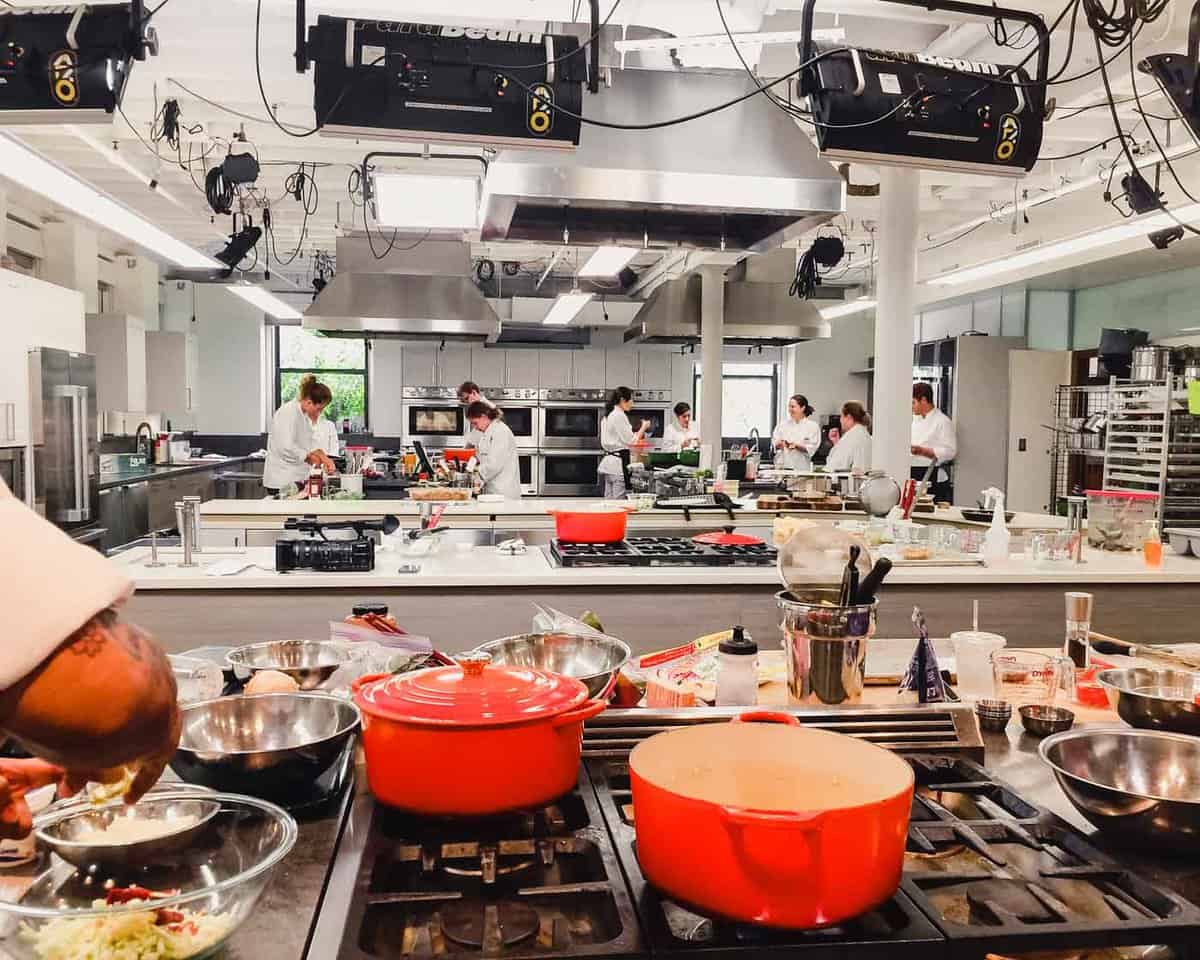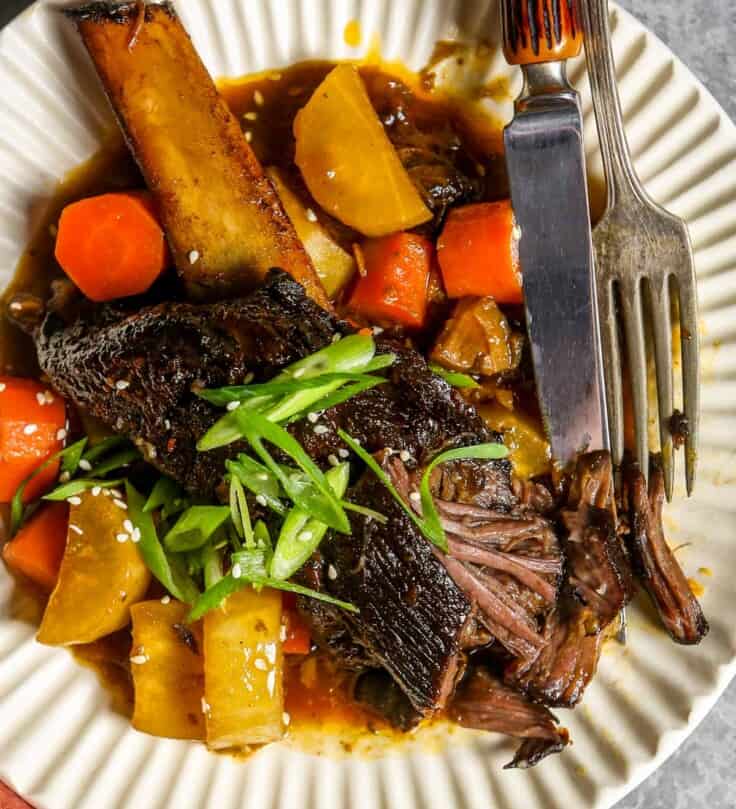Korean Beef Stew, made with glazed Korean beef short ribs, is the perfect dinner party recipe. It’s impressive yet cozy and easier to make than it looks. Featuring the most decadent and delicious fall-off-the-bone short ribs in an umami-rich stew, each bite of this beef Korean stew is satisfying and nuanced.
I’m beyond excited to share this recipe with you! I’ve been dreaming up a sticky-glazed Korean beef short rib recipe for a while. And pairing it with a simple, yet hearty stew was the final piece needed in order to bring it to life.
The ingredient list is fairly simple with just a handful of specialty items like gochujang, mirin, and Daikon radish. After a bit of stove-top cooking, most of the work is done in the oven which makes this a great dish for when you have guests coming over. The short ribs braise for a few hours, releasing thickening collagen into the broth and resulting in meltingly tender beef.
If you end up having some leftover cooked beef, I recommend using it to make my Beef Ramen!
Table of contents
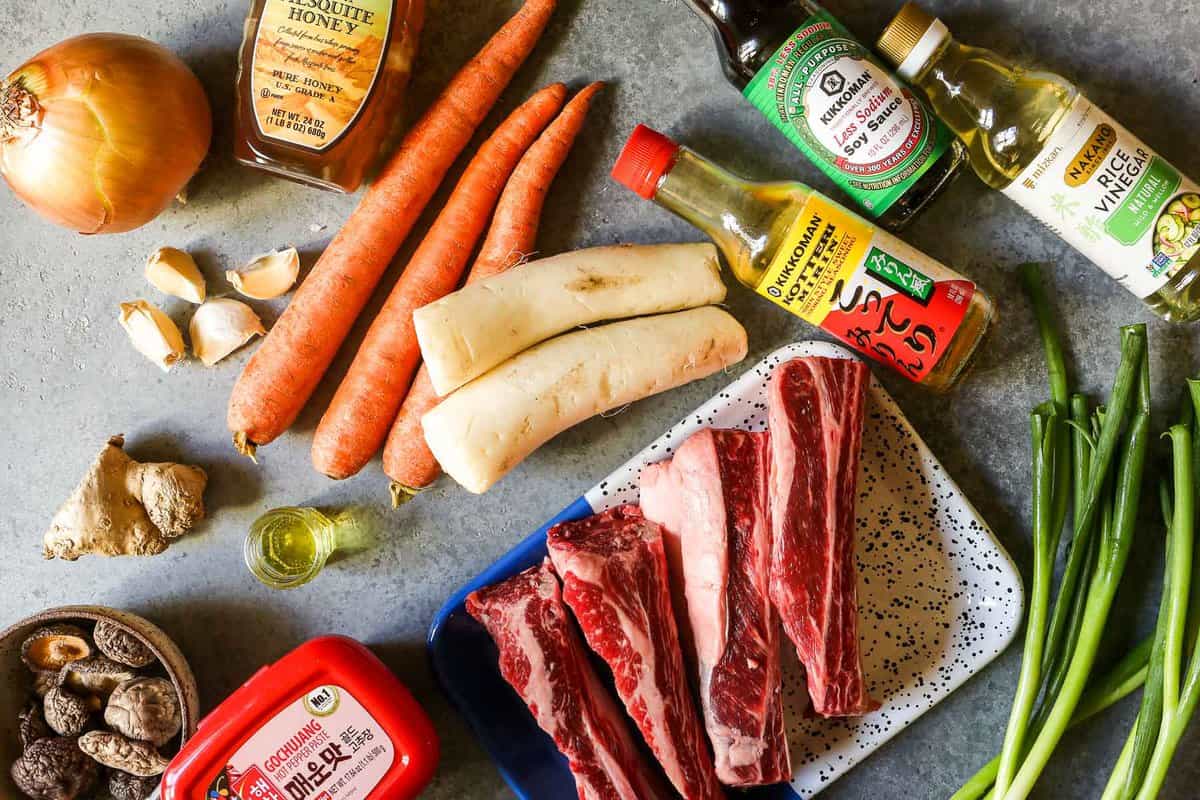
Ingredients Needed
- Beef Short Ribs: there are three ways short ribs are sold. Boneless, English Cut and Flanken. For this recipe you are looking for English-Cut short ribs that have been cut crosswise into 4- or 5-inch long ribs. If your meat counter only has full ribs, ask them to cut them in half, crosswise.
- Onion and Garlic: this recipe uses 1 onion and 4 large cloves of garlic. Yellow or white onion works but avoid red onion.
- Ginger: you’ll need a fairly large piece of ginger since the recipe calls for ¼ cup diced.
- Gochujang: this is one of my favorite ingredients to cook with—it’s sweet, spicy and savory. Gochujang is a Korean chili paste and is generally sold in short red plastic containers. You’ll need a ¼ cup for this recipe. Keep the opened container in the refrigerator and use it in my Korean Meatballs, Gochujang Noodles (a reader favorite!) and Steak and Eggs.
- Soy Sauce: I develop recipes using low-sodium soy sauce. If you’re using regular soy sauce, pull back on the salt elsewhere in the recipe.
- Dried Mushrooms: you’ll need 1 ounce of dried shiitake mushrooms. They add loads of savoriness and meaty texture to the stew. Look for them in the produce area near the onions, potatoes and garlic, or near the sundried tomatoes and dates.
- Honey: a few tablespoons of honey is the base of the gochujang glaze for the ribs.
- Mirin: Generally used in Japanese cooking, mirin is a rice wine high in sugar and low in alcohol. A lot of products on the market (such as Kikkoman) are sold as “mirin-style” or “aji-mirin” which translates to “tastes like mirin.” Any of these products will work. If you can’t find mirin, substitute with 2 tablespoons dry wine, 2 tablespoons vinegar and 2 teaspoons sugar.
- Carrots: a few large carrots are needed for this recipe. Cut them into large chunks so they hold their shape and retain a nice texture during simmering.
- Daikon radish: Daikon is a common ingredient in Korean cuisine and adds an earthy yet bright flavor to the dish. I usually find daikon at Whole Foods. If you can’t find it, you can substitute with additional carrots (ideal) or gold potatoes.
- Vinegar: rice vinegar or distilled white vinegar will work here. You just need a splash. Avoid using any balsamic varieties.
- Scallions: just a few scallions are needed for finishing off the soup. Slice them thinly and garnish each serving. They add a much needed brightness to the dish.
How to Make Korean Beef Stew
- Brown the beef short ribs in a large Dutch oven in batches until deeply browned on all sides. Transfer the beef to a sheet pan and set aside.
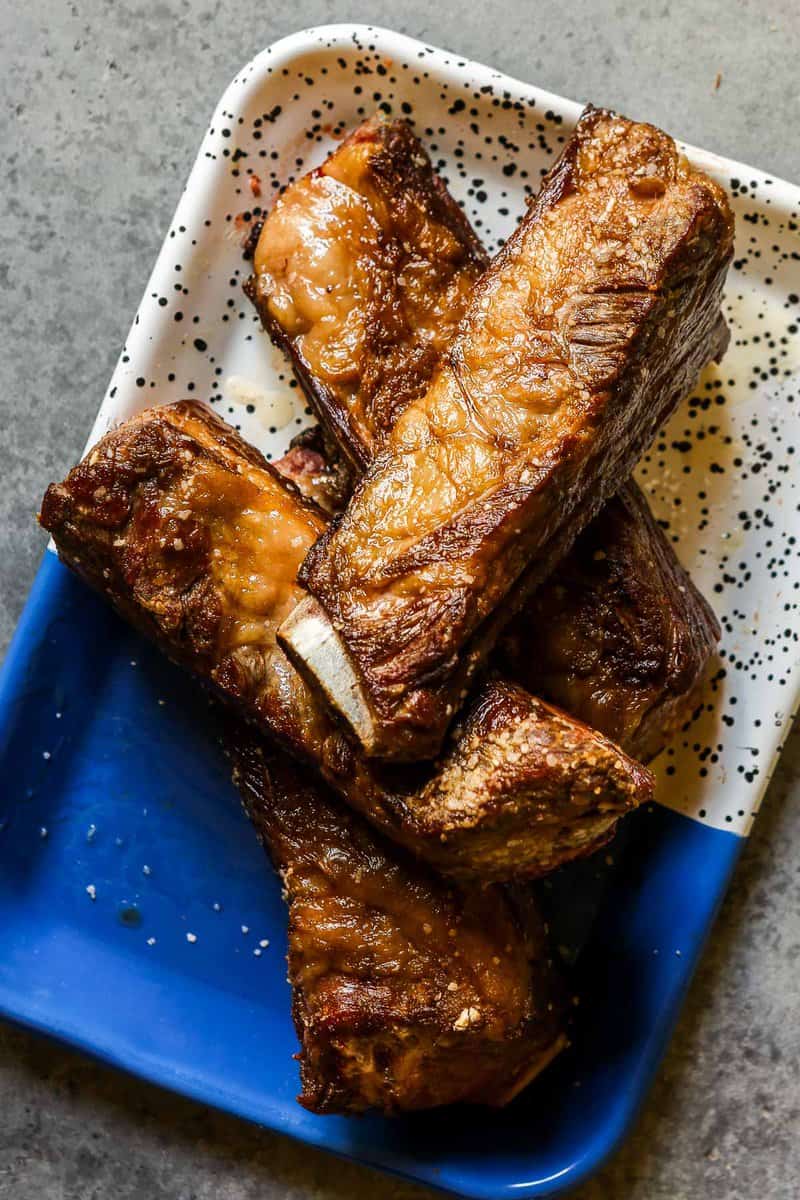
- Caramelize the onion, garlic and ginger in 2 tablespoons of drippings in the pot. Cook, stirring occasionally, until the onions start to soften and brown.
- Add the water, soy sauce, a couple tablespoons gochujang and the dried mushrooms. Bring the liquid to a boil.
- Nestle the browned beef short ribs into the pot, you may need to tetris the ribs a bit to get them all to fit. And be sure to place the ribs so the meat is facing down, into the broth and the ribs are facing up.
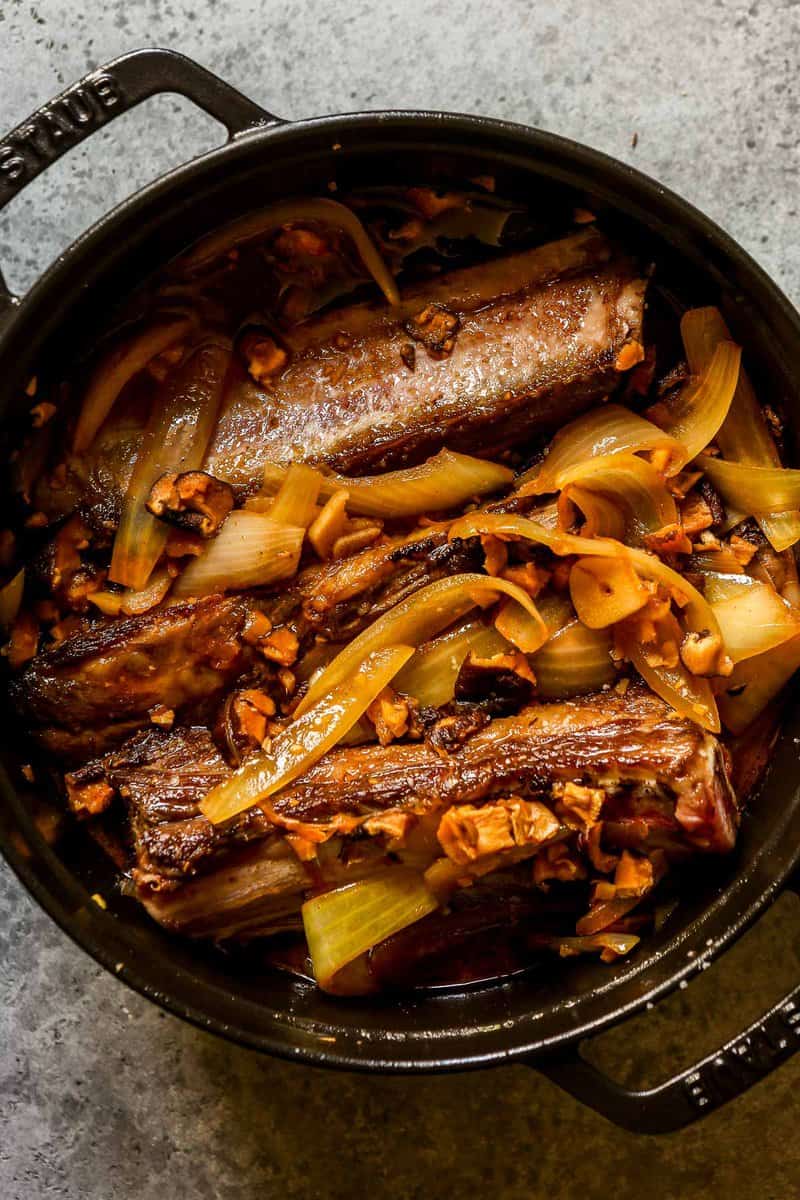
- Cover the pot and transfer it to a 325ºF (163ºC) oven and braise for 3 hours or until the beef is tender and shreds easily with a fork. Meanwhile whisk together the gochujang glaze by combining gochujang, mirin, and honey.
- Gently remove the ribs from the stew and transfer them to a sheet pan. Brush the shortribs with the gochujang glaze and transfer to a 425ºF oven. Roast the short ribs until they are browned and sticky, about 25 minutes.
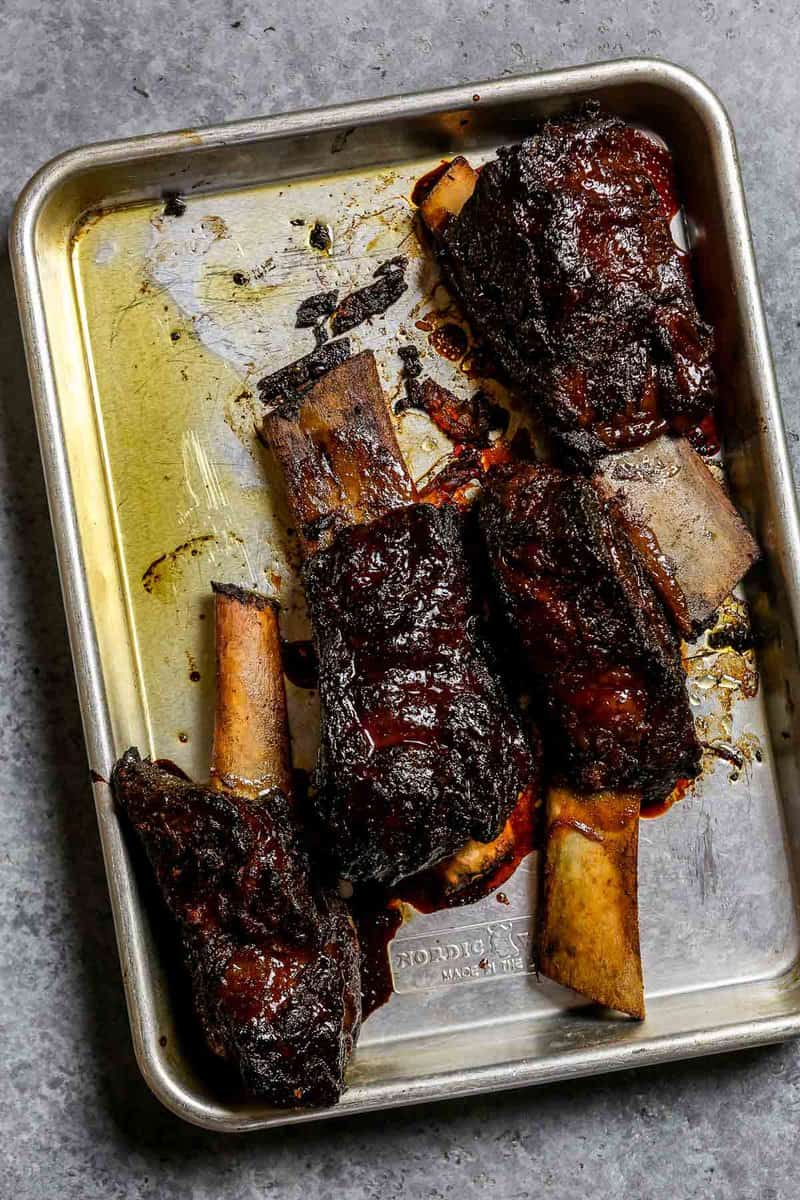
- White the short ribs brown, skim and discard the grease from the stew (there will be quite a bit). Stir in additional water, carrots and daikon and bring the stew to a simmer. Cook the stew, partially covered, until the carrots are tender, this will take about 15 minutes.
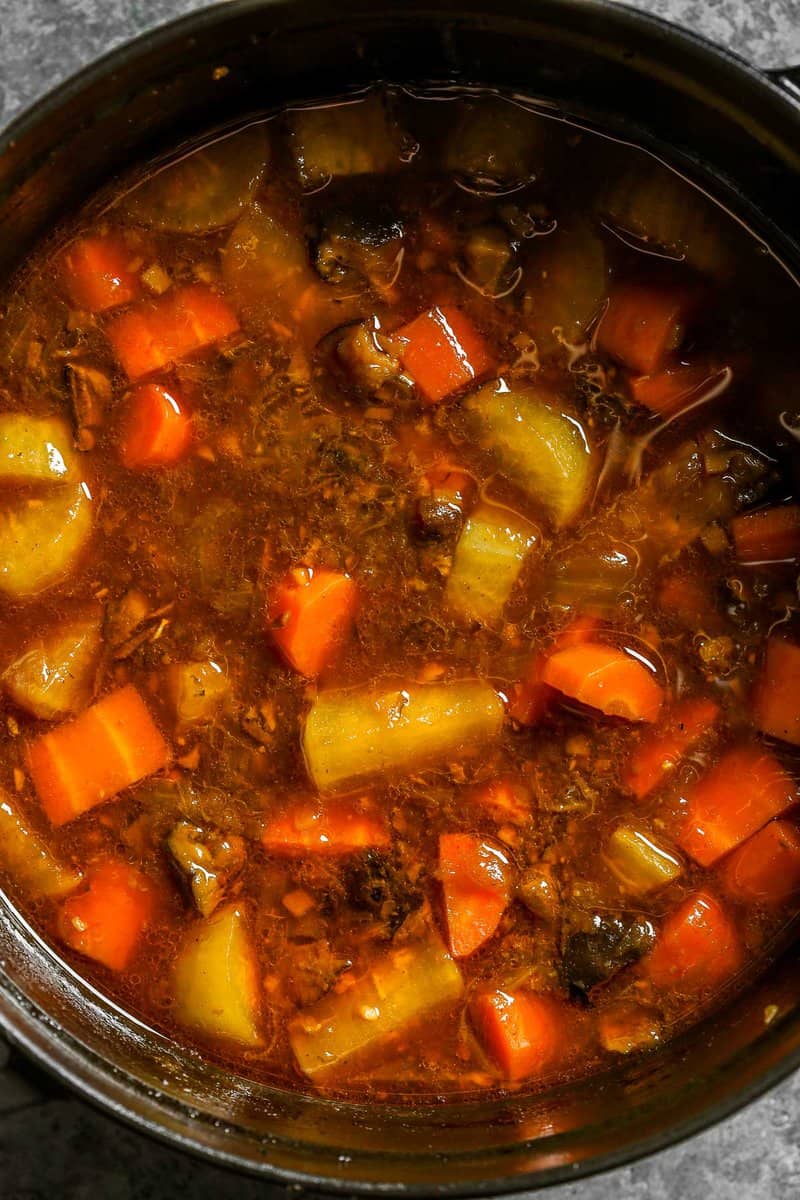
- Finish the stew by stirring in a couple tablespoons of mirin and a splash of vinegar. Season to taste with additional salt, mirin and vinegar. Serve the stew by spooning stew into a bowl and topping with a beef short rib. Garnish with scallions and sesame seeds.
Expert Tips
- As I mentioned above, there are three ways short ribs are cut and sold. Boneless, English Cut and Flanken. For this recipe you are looking for English-Cut short ribs. This means the ribs are separated from each other and the meat runs along the top of the bone. You will likely find them left as whole-sized ribs (8–10 inches long) or cut in crosswise into 4- or 5-inch rib pieces. I recommend buying ribs that have been cut into 4- or 5-inch pieces or asking your butcher to cut them in half for you.
- Beef short ribs are really fatty, which is why they are so flavorful. Because of that, during a low and slow braise, the fat is rendered into the braising liquid. Before finishing the stew, it’s important to skim and remove the excess grease or the finished dish will be far too greasy. Use a ladle or large shallow spoon and be patient—you want to remove as much grease and as little broth as possible.
- Daikon radish can be tough to find, but if you can, this is a great recipe to use it in. It’s a traditional Korean ingredient and adds a unique flavor. If you can’t find it, substitute with additional carrots or try gold potatoes.
- This recipes uses gochujang, though often used in similar applications, gochujang shouldn’t be confused with gochugaru which is a dried chili powder.
How to Serve
This beef Korean stew is an all-in-one meal. If you’re looking for a few side dishes to pair with it, here are some of options:
- Make a batch of Milk Buns—they’re soft, fluffy and slightly sweet. They’re the perfect dinner roll to sop of the last drop of the stew with.
- Or try Cheese Biscuits! They’re made with a bit of rye flour and studded with salty feta cheese.
- Add a bit of brightness and pair this Korean beef stew with a fruit salad. Try a Grape Salad or Citrus Salad.
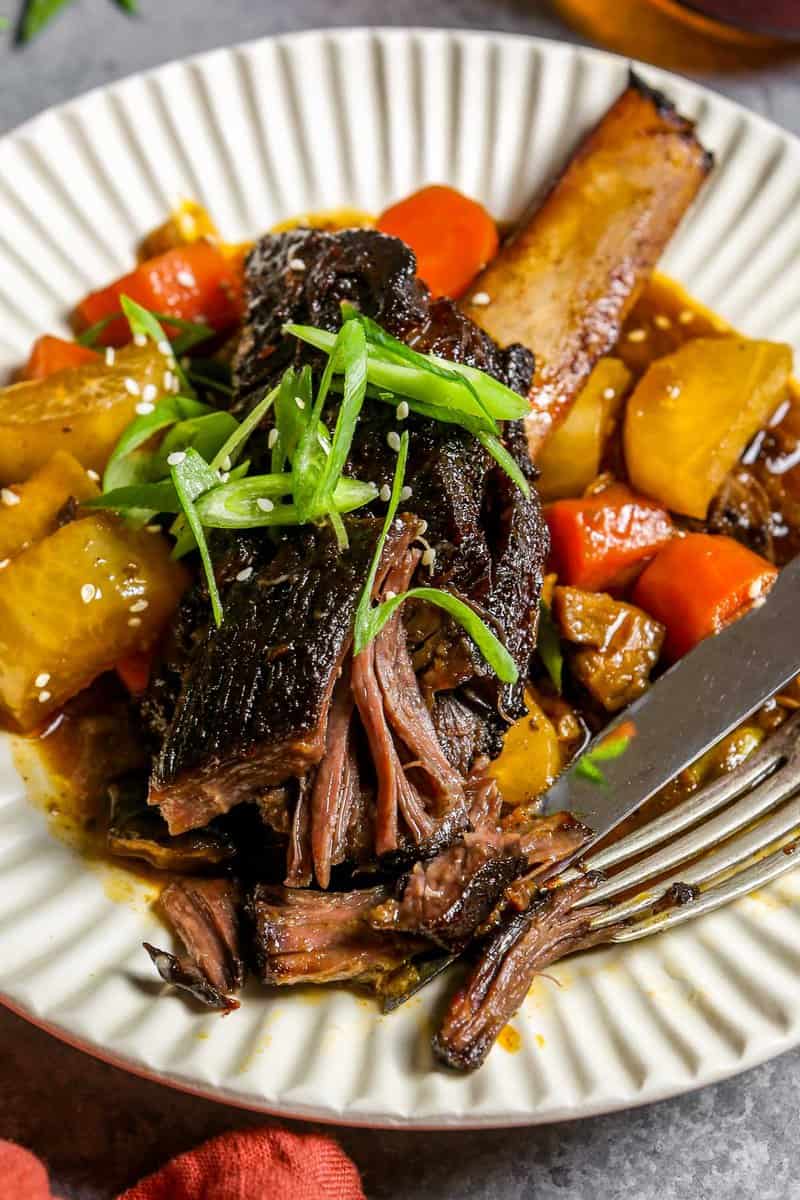
More Korean-Inspired Recipes to Try
We’ve got loads of Korean-inspired recipes here, many of which are made with beef! Here are some to try:
- If you love Korean BBQ then you’ve got to make Beef Bulgogi or our weeknight-friendly Ground Beef Bulgogi.
- Make Korean-style Steak and Eggs for dinner! It’s a protein-packed brunch or dinner made with skirt steak and a side of quick pickled cukes and pickled onions.
- Brush this homemade gochujang sauce over Top Sirloin or Ribeye Steak and serve with Korean Cucumber Salad for a spicy and satisfying dinner.
Korean Beef Stew Recipe
Description
Ingredients
- 3–3½ pounds meaty beef short ribs*
- 1 tablespoon canola oil or avocado oil
- 1 yellow onion, trimmed, halved and cut into wedges
- 4 large cloves garlic, sliced
- ¼ cup finely diced fresh ginger
- 4 tablespoons gochujang, divided
- ⅓ cup low-sodium soy sauce
- 1 ounce dried shiitake mushrooms, roughly chopped
- 3 tablespoons honey
- 4 tablespoons mirin, divided
- 3 large carrots, cut into 1-inch chunks
- 1 large Daikon radish (¾ pound), cut into 1-inch chunks
- 2 teaspoons rice vinegar or white vinegar
- 2 scallions, thinly sliced
- Sesame seeds for garnish, optional
Instructions
- Heat oven to 325ºF (163ºC) with rack set in middle position.
- Heat oil in a dutch oven over medium heat until shimmering. Season beef with 2 teaspoons kosher salt. Add half of ribs to pot and sear until golden brown on all side, about 8 minutes.
- Transfer ribs to a sheet pan or plate. Repeat browning with remaining ribs. Drain off all but 2 tablespoons grease.
- Add onion wedges, 4 sliced cloves garlic and ¼ cup minced ginger to drippings and cook, stirring frequently until onion starts to caramelize, 5–7 minutes.
- Stir in 2 cups water, ⅓ cup low-sodium soy sauce, 2 tablespoons gochujang, and 1 ounce chopped dried shiitake mushrooms. Bring to a simmer then nestle ribs back into pot, meat side down, scooping up onions and placing over beef to allow all of the beef to be submerged.
- Cover and transfer to oven; braise until beef is tender and easily falls off bone, 3 hours.
- Remove pot from oven and gently transfer beef to a sheet pan. Increase oven temperature to 425º (218ºC) and set rack to upper-middle position. In a small bowl whisk together remaining 2 tablespoons gochujang, 3 tablespoons honey, and 3 tablespoons mirin. Brush glaze over ribs then transfer ribs to oven and roast until deeply browned and crisp, about 25 minutes.
- Meanwhile, skim fat from pot then stir in 2 cups water, 3 cubed carrots and 1 cubed Daikon, bring to low simmer and cook, partially covered, until carrots are tender, about 15 minutes. Stir in 1 tablespoon mirin and 2 teaspoons rice vinegar; season to taste with additional salt, mirin and vinegar.
- When ready to serve, place a bone in a serving bowl and spoon soup over top. Garnish with scallions and sesame seeds.
Equipment
Notes
If you can’t find dried mushrooms, you can substitute with fresh—though keep in mind the resulting broth won’t be quite at umami-rich. After step 3, cook ½–1 pound fresh, sliced shiitake or cremini mushrooms in the pot with 2 tablespoons of drained drippings. Cook, stirring only occasionally, until golden brown. Season the mushrooms with a tiny bit of salt near the end of cooking. Transfer the mushrooms to a bowl and continue with step 4. Add the mushrooms to the pot, over top of the ribs, at the end of step 5. Beef Broth: for the deepest flavor, I recommend using Better than Bouillon Beef Base. It’s economical and far more flavorful than the stuff you can buy in the boxes or cans. Skim the grease: before finishing the stew, it’s important to skim and remove the excess grease or the finished dish will be far too greasy. Use a ladle or large shallow spoon and be patient—you want to remove as much grease and as little broth as possible. Daikon radishes can be tough to find, but if you can, this is a great recipe to use them in. Daikon radish is a traditional Korean ingredient and adds a unique flavor. If you can’t find it, substitute with additional carrots or try gold potatoes. Mirin: If you can’t find mirin, substitute with 2 tablespoons dry wine, 2 tablespoons vinegar and 2 teaspoons sugar.
Nutrition
This post is written and created in partnership with the Iowa Beef Council. As always the thoughts, opinions, recipe, photos and content are all my own.
